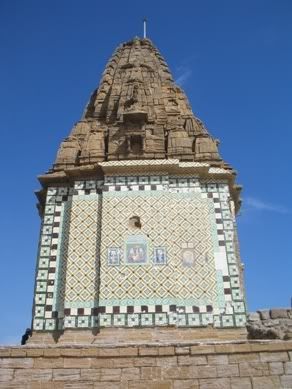 In the past we have shared with you some photos of Manora Island under the title views of Manora. Today we will go on an exclusive tour of Shri Varun Dev mandir located at the Manora beach.
In the past we have shared with you some photos of Manora Island under the title views of Manora. Today we will go on an exclusive tour of Shri Varun Dev mandir located at the Manora beach.
(Photo to the right is the view of the mandir facing Arabian Sea.)
The mandir is unfortunately in a bad condition of disrepair and salty-rusty sea breeze is eating away into the structure fast. When I visited the mandir on Jan 7, 2007, it appeared deserted. There were unfortunate signs of human vandalism also where it looked like people took away with them any item salvagable. The structure still appeared grand and from left over tile work and decorations it showed its glorious past.
Date of Construction:
Mr Hari Motwani, who is General Secretary of Pakistan Hindu Council – 2009 provides a brief history and year of construction of this mandir in his comments below in following words:
(The Mandir was) built in 1917 (record available) and renovated in 1937-40 (tiles fixed). Lokram Dodeja, journalist from Shikarpur, have given reference in his book -1938 that he used to visit Monora Mandir every Sunday, (where) he got Saag & Dhodho as parsad, (and) the well inside the temple had sweet water.
(2) Here is a memorial tablet in Sindhi on one of the mandir gates.

Our avid reader Khair Soomro saheb helped me in translating this tablet. It reads:
“dedication from sons in the sacred memory of Seth Harchand Mal Dayal Das of Bhriya”
or in other words: “An offering from sons in the loving memory of their father Seth Harchand Mal Dayal Das of Bhriya”. (Bhriya is a town near Khairpur Sindh.)
(3) View of the mandir from West side
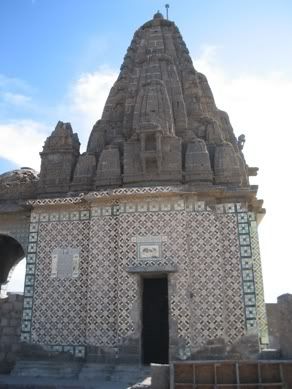
Note the details of the elaborate stone work done on the roof of this mandir. The tile work near the base is in obvious state of disrepair. I took this photo of January 7, 2007.
(4) This tablet tells us about the sponsors of colorful tile work in two languages.
Top script is Sindhi.
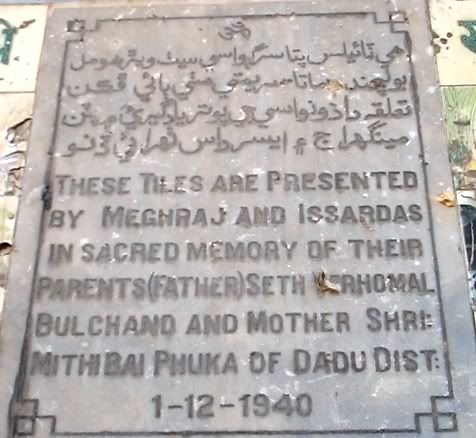
(5) The tile work of mandir floor

(6) Looking at the mandir from east
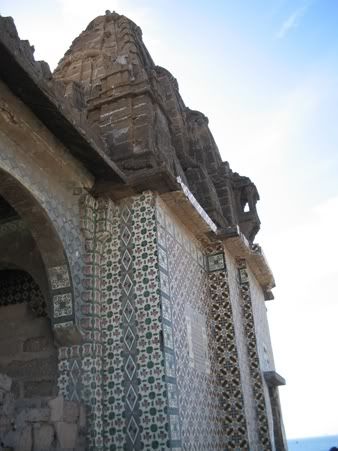
(7) The outer gate of the mandir
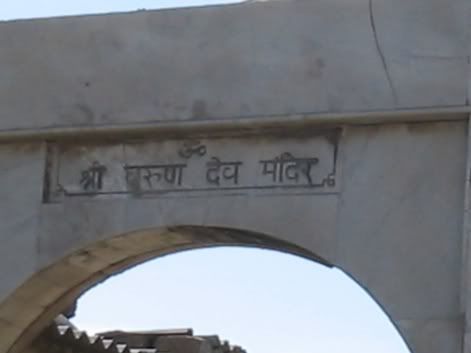
I asked my good friend Sridhar to translate the devnagri script for us and here was his reply:
“The top line has the character ‘Om’. It is just an auspicious syllable that is there in most prayers and is also present in most places of worship. The second line has the name of the temple (and presumably the chief deity worshipped there). It says ‘Shri Varun Dev Mandir’. The name also looks like ‘Shri Arun Dev Mandir’ (the ancient way of writing ‘A’ in Arun could well be imagined in that character, which is not that clear. But I think, on balance that it is Varun Dev and not Arun. According to Hindu mythology Varuna is the God of the oceans. There is no worship of Varuna that I have come across personally in India, though I would not be completely surprised at the existence of this temple in Karachi because of the enormous diversity in the Hinduism practiced in different parts of the subcontinent. Also, people who have livelihoods related to the ocean, for instance, fishermen, might worship Varuna. If this temple is on the beach in Karachi this could well be an explanation – it might have been built by fishermen who worshipped Varuna.”
I have a sincere hope that Government of Pakistan takes care of these places of worship. If nothing else then atleast the structure should be saved from the people who take away tiles and anything salvagable for petty profits. Many people visit the mandir as it is the largest and most prominent attraction at Manora beach. A little bit of official or non-official help will go a long way in preserving our heritage.
(8) View from the outer most gate of the mandir compound
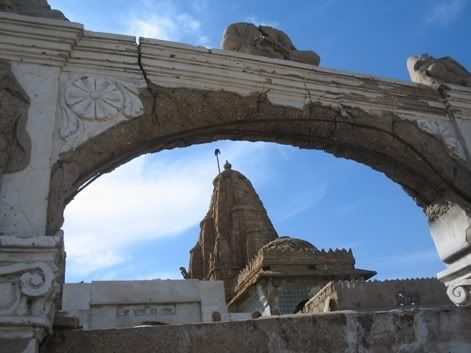
I’ve recently read that in June 2007, The station Commander PNS Himalaya Manora cantt has handed over the control of this temple to Pakistan Hindu Council Karachi, which is now working on the restoration work. PHC’s website introduces the mandir in following words:
Varun God (Radha Krishna – Sita Ram) Temple At Manora Cantt
The temple is situated on seashore of Manora cantt. This temple is about 160 years old (1850s?reference needed about this time line) and designed perfectly as per Hindu Architecture. The temple is carved from a blackish marble. Apart of Varun Devta temple there is small temple of Shiv Shanker & statues of Hanuman & Sri Ganesh Mahraj are still in good condition. Sindhi Hindu Businessmen built this temple & renovated from time to time. After partition the temple was abandoned and illegally occupied by land grabbers, recently Pakistan Hindu Council Karachi took a bold step to renovate the same and how have brought back the sanctity of temple & have been cleaned of all the impurities & garbage inside the temple. The station Commander PNS Himalaya Manora cantt has very kindly handed over the control of this temple to Pakistan Hindu Council Karachi, from June, 2007.The Council plans to spend about Ten million rupees for uplift and to bring this ancient temple to its original condition. Satsung will be held on every Saturday and Parsad and Bhandara would also be managed every week free of cost. Lot of devotes visit this picnic place and enjoy the waves of sea direcltly hitting the temple. There is beautiful scene early in the morning at sun rise. The atmosphere is marvelous and one feels great pleasure & peace of mind along with glimpses of the temple and Darshan of Lord Shri Ram and Lord Shri Krishna.
(9) Following is the tile work on mandir’s exterior wall
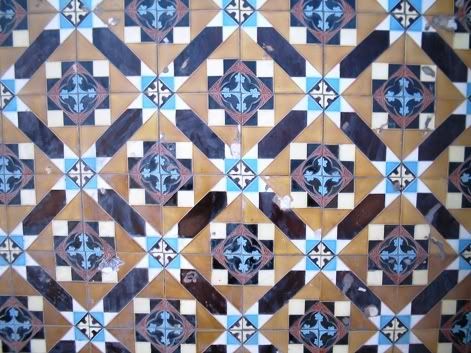
Reference: Pakistan Hindu Council



















































Sridhar
Thanks for finding the 1930s photo of the mandir as well other valuable information you have shared.
Owais
Here’s a picture of the temple from the 1930s.
http://www.harappa.com/post4/karachi07.html
The tiles are a later addition (the plaque mentions 1940). Additionally, it seems like it used to be whitewashed in those days. Comparing the recent pictures with that in the link above, it is not obvious that the temple is necessarily in a state of major disrepair. It might be abandoned, but the basic structure looks quite similar. The damage may be mostly to the tiles and other non-structural elements – and can probably be fixed quite easily.
How old is this temple? The plaque of Harchand Mal Dayal Das in Sindhi seems to suggest that it might not be that old (19th or even 20th century), but the plaque might refer to a refurbishment of an older structure or additions to it. It would be interesting to know something about its history.
The architectural style is the Nagara style – seen in temples all over North India. Ancient surviving examples of that style includes the complex of temples in Khajuraho, dating from the 10th century. Most medieval temples in north India also followed this architectural style (or sometimes the Orissa style). It is characterized by a narrow tapered tower (called the ‘shikhar’) with a square base, overlaid with cutaway sections of smaller reproductions of itself. The ‘shikhar’ often has a circular structure on the top, called the ‘amalaka’. This particular temple in Manora is quite simple and not large or ostentatious, but typical examples of this style also include several layers of embellishments carved into the ‘shikhar’.
On a different note, I remember reading sometime ago about a visit by Pres. Musharraf to this beach, when he saw the current state of the temple and ordered its restoration.
Mr. Italiana: The beautiful tile work is a reflection of the local tradition. One sees similar tile work typically in Mosques. These are locally produced ceramic glazed tiles from Hala, Sindh and may be from Multan and Bahawalpur in Punjab. The art of glazed tiles and ceramics was introduced into various areas of Pakistan by the Persians and the Turkic Central Asians who took it from Chinese. However the structure is typical of the Hindu (or pre-Islamic) architectural design. You are simply thrown off by the use of tiles and marbles, not typical of a Hindu temple in Sindh or Baluchistan..
Yet another informative post!
I haven’t seen that kind of mandir architecture anywhere. The tilework seems unique (but by no means have I ever conducted a thorough and exhaustive survey of all mandirs, so it could very well be that there are architectural similarities between this mandir and others across the subcontinent.)
Does anybody know how many mandirs there are in Pakistan?
Also, where do most Hindus in Pakistan live? Or are they scattered communities?
And finally, what practices do Hindus in Pakistan generally engage in? Meaning, which sect, etc (I know it is difficult to neatly delineate and define given the fact that Hinduism is very diverse and highly regional).
I doubt if Pakistani government or Muslims will do any thing to preserve this structure. We come from a long line of ‘idol smashers’ and not ‘temple preservers’. It is part of our tradition. The best way to preserve this building is that effluent Hindus from West (not from India, that will not fly) join hands with the Hindu community in Karachi and do the job themselves. Muslims do not consider temples as their ‘heritage’ as Mahendra puts it. Those who want to save the building they have to do it themselves. Sorry to say that but these are the realities.